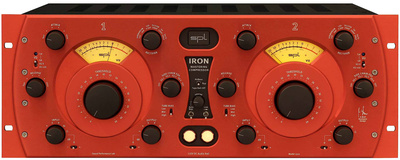SPL Iron V2 Compressor red
5.949,00 €*
Verfügbarkeit: Bitte kontaktieren Sie uns in dringenden Fällen.
Produktinformationen "SPL Iron V2 Compressor red"
IRON
Mastering Compressor
The IRON Mastering compressor combines not only the sonic virtues of legendary vintage tube compressors with the advantages of the High Dynamic 120V operating voltage in a single unit. It is also perfect for the needs of modern mastering studios and sets a new benchmark in terms of tube compressor technology, with the innovative implementation of a parallel dual-tube circuit.
Thanks to the especially conceived Mu-Metal iron transformers, the signal of each channel is split across two different twin-triode tubes. The combination of the different response curves of both tubes results in a transparent and musically pleasant compression. Additionally, peak signals of the control voltage are limited by a feed-forward resistive vactrol-opto-isolator. Thus, the output signal remains lively even with a high gain reduction. The compression is only noticeable with extreme settings.
The Tube Bias has three different settings. Together with the Input Gain of up to +/- 12dB and the Threshold control, it allows the compression behavior of the tubes to be perfectly adapted to any material.
The Attack and Release parameters have six different settings ranging from Slow to Fast. The times are not constant, they vary according to the Rectifier circuit selected: There are six different Rectifier settings available with different diodes (germanium, silicon, LED, mixed).
The Sidechain EQ is yet another option to adjust the Iron to the signal being processed in an optimal way. It allows you to choose between an external EQ or one of the four internal EQ presets. The EQ presets have a complex frequency response and have been conceived with different program material in mind. Only the control signal is affected, not the actual audio signal. In the Off position, the Sidechain EQ is inactive.
After the compression stage, the signal can be boosted or attenuated up to +/- 12dB with the Output Gain, which makes the Iron easy to integrate into any signal chain.
All functions can be adjusted via switches or, in the case of the Threshold, with a detented potentiometer, making it easy to replicate exact settings.
In stereo Link mode, the Threshold, Tube Bias, Attack, Release, and Rectifier parameters, as well as the Sidechain EQs, are controlled with the right side (channel 2) of the unit. In contrast to the Dual-Mono mode, in stereo Link mode the compressor works with a sum signal. Thus, the stereo image is wider when working with the Dual-Mono mode on stereo material.
The compressor has an additional passive 120V equalizer to give the output signal the finishing touches. You have two different EQ presets to choose from: AirBass and Tape Roll-Off. The AirBass mode gently boosts high and low frequencies approx. 2dB. For its part, the Tape Roll-Off mode is based on the frequency response of a tape machine and uses a high and a low-cut filter.
Both the left and right channels have separate illuminated activating switches. Further, in Auto Bypass mode you can use the Interval control to set a time frame during which the compressor automatically toggles back and forth between the processed and unprocessed signals. This makes AB comparisons between the original and compressed signals a breeze, besides making it easier to assess the settings in context.
The ergonomic design and clear arrangement of the control elements make working with the compressor more intuitive, while its shallow housing makes the Iron perfectly adaptable to tabletop rack stands.
Mastering is not the only domain where the IRON sets new standards. It can also be used to process individual instruments, like vocals, bass, guitar, strings, etc. The IRON is also an excellent option for subgroups.
Operating Principles of a Compressor
The basic operating principles of a compressor/limiter can be easily explained. The level of an audio signal is reduced according to the specified attack time and ratio whenever it exceeds a given threshold. This reduction ceases when the release time elapses, while the compressed signal is amplified with the make-up gain.
Compressors basically differ from each other in the technology used. This technology - tubes, opto, FET, or VCA - is what gives a compressor its particular character. Some units sound soft and silky, some sound pounding, while some others make sound fatter, and there are those that make sound clearer, harder or more percussive. The trick resides in how the unit is technically designed, in the signature of the maker. Different compressors with the exact same settings might work and sound completely different. They provide different sounds for different applications and music styles.
Nowadays, the compressor has become a key element when it comes to provide dynamicsand punch to any production. The number of compressors available is huge and it‘seasy to succumb to the promises made by software emulations and analog recreations ofvintage gear as the perfect solution. Unfortunately, many of these emulations and recreationsdiffer quite a bit form their original counterparts. You must simply accept that the components used today, like the transformers, tubes and all other passive elements, are different to the ones originally used and that they can‘t be digitally emulated. No software (DSP-emulated compressors) or hardware replica will ever be able to sound like the original. An authentic sound can only be achieved with the original unit.
Innovating Compression
The IRON mastering compressor was conceived as a variable-bias limiter/compressor right from the start. However, the implementation of new technologies results in many improvements. Its basic operating principle as a variable-bias tube compressor was loosely inspired by the sonic and technical operation of Fairchild, Collins and Gates compressors, which used remote cut-off of tube biasing to achieve a well-balanced, well-compensated and musical compression.
However, the IRON compressor features a second sharp cut-off tube, a medium-variable bias triode, in its circuit design. This tube is connected in parallel to the remote cut-off tube and it has a considerably steeper characteristic curve. The tube used to process the signal depends on the amplitude of the latter. This results in a more well-balanced sound and more controllable settings of the parameters. The pair of parallel connected tubes has been specially matched for the IRON. In order to guarantee that tube selection and pairing is perfect, we use the Weigl Roe Test for PC. The optimal selection of the tubes guarantees that all IRONs have the same sonic characteristics.
Moreover, we use Lundahl custom-made balanced high-level dual-coil mu-metal iron transformers in the signal flow of the variable-bias tubes, which add to the overall sound.
The second new technology implemented is the independent feed-forward resistive opto-isolator in the control path of the variable-bias tube circuit. Its function is to limit signal peaks and, thus, get a smaller THD (Total Harmonic Distortion) within the variable-bias tube section. The result is a silkier, more homogeneous sound in the higher frequencies of the music signal. This circuit has its own rectifier in the signal path. The optical control element does not work in the sense of an audio limiter, like in a conventional opto-compressor. It is built-in in the control path of the parallel connected variable-bias tube, not in the audio path itself. Time control parameters, like attack and release time, are adaptedand fixed to the variable-bias tube circuit.
The IRON compressor works as a feedback compressor when set to the variable-bias tube circuit and as a feed-forward compressor when set to the opto-control circuit.Thirdly, the complex rectifier circuit is also worth mentioning, since it is the basis for tube control. You can use the six-position switch to choose either of the six different control characteristic curves of the diodes within the rectifier. Given the specific characteristic curve of its elements, the combination of germanium, silicon and LED diodes produces different behaviors and characteristics for the Attack and Release times.
Hence, compared to most compressors, the application scope of the IRON is clearly enlarged, resulting in new possibilities regarding the processing of music material. The fourth exceptional feature is the comprehensive logical relay circuit that perfectly links both channels together, making the right channel the Master regarding Release, Attack, Threshold, Rectifier, Tube-Bias and Side-Chain EQ settings.
120 Volt Technology
SPL‘s goal was to push analog signal processing to the limits. That‘s why we combined the best possible components with a high-grade optimized circuit design. We have been using the in-house developed 120 volt technology - the highest-ever operating voltage used for audio applications - in all our products of the mastering series for years.
Some of the most highly respected mastering studios today revolve around SPL consoles and signal processors from our mastering series (Bob Ludwigs Gateway Mastering & DVD in the USA, Simon Heyworth‘s Super Audio Mastering in the UK, Galaxy Studios in Belgium, and the legendary Wisseloord in the Netherlands, for instance).
The 120 volt technology is based on op-amps developed internally by SPL‘s founders together with chief developer Wolfgang Neumann. The IRON features the most advanced generation of these op-amps. They boast better tech specs thanks to the thermal behavior optimization they underwent under the hands of Bastian Neu. Ultimately, the supply voltage is key for the overall dynamic response of a processor. Voltage is to an electrical circuit what cylinder capacity is to an internal combustion engine. You can‘t replace cylinder capacity with anything else, except more cylinder capacity.
| Sicherheits- und Warnhinweise: | Die spezifischen Sicherheitshinweise für das Produkt sind in dessen Bedienungsanleitung aufgeführt. |
|---|

SPL
SPL electronics GmbH
Sohlweg 80 41372 Niederkrüchten Germany
info@spl.audio
https://spl.audio


